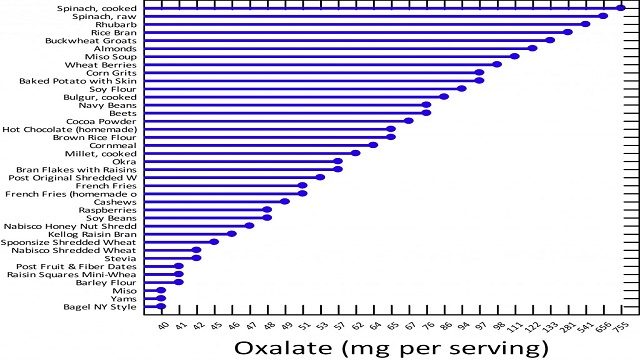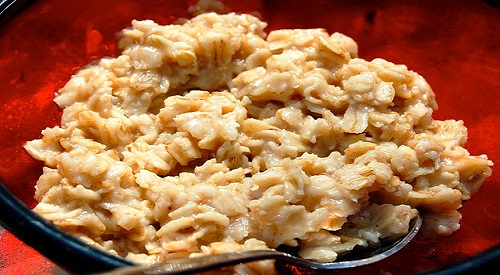Like we’d expect with most other cereal foods, is oatmeal high in oxalates? We will confirm this in a moment — below.
But basically, most nutritious foods contain more oxalates. And since your body REALLY needs certain nutrients to stay healthy, the way to lower oxalate content in foods is using an oxalate reducing enzyme in your meals. Personally I found one really helpful oxalate reducing agent on Amazon, (click here to have a view of it).
Back to our question, is oatmeal high in oxalates? Yes, but note this before you drop it, the cereal is very nutritious. Oatmeal is made from oats and most people prefer to take oatmeal’s porridge for breakfast. For me, oatmeal makes a great evening after-work beverage because it brings back that strength after a long day.
In their natural state, oats are known to be among the healthiest grains you’ll ever come across. We’ll clarify this also based on clinically approved charts, graphs, and research-based pdf files.
But first what is the:
Difference between Oats and Oatmeal
The simplest explanation is, oats are the grains — now, after processing the seeds, they can be mixed and boiled with water or milk to make a type of porridge that is called oatmeal.
Basically, when answering the question whether oatmeal is high in oxalates, we must analyze the grain and its nutritional constituent to be able to judge right.
Most studies have shown that eating oats come with many health benefits. These may extend to reduced risk of heart disease, weight loss, lowering blood sugar in diabetic patients, and more.
But for people who have to stick to a low oxalate diet, the intake of oatmeal needs to be regulated depending on the severity of their oxalate-related condition.
A person with severe leaky gut or serous fibromyalgia may want to completely avoid oatmeal, while an individual with gout may have it in small portions.
Mineral Constituents of Half a Cup of Oat (talking of 78 grams of dry oats)
In just that small amount of oats you’ll get:
- Manganese:190% of the RDI
- Magnesium: 34% of the RDI
- Phosphorus: 40% of the RDI
- Iron: 20% of the RDI
- Copper: 24% of the RDI
- Vitamin B1: 39 percent of the RDI, and 10% of the RDI for Vitamin B5
- 11% of the RDI – Foliate
Looking at the above percentages, how oats are rich in minerals, it is clear that these grains are rich in oxalates. However, those are the figures that make oatmeal a great supplement when a person needs any of the nutrients as compensation.
Is Oatmeal High in Oxalates?

source: ndtv food
Again, the answer is yes. Oatmeal is generally listed as a very high in oxalate food, not among the medium level oxalates. If on a strict low oxalate diet, it is highly advisable to regulate the meal, or, consult with your doctor to confirm whether the state of your condition can allow you to have the oatmeal porridge in small measures.
But generally speaking, people with calcium oxalate issues that trigger kidney stones might want to completely keep a low oxalate diet profile. On the same note, they’ll want to avoid the dark chocolate because it has been noted to be among the recipes that promote stone formation faster.
what foods are high in oxalates?
You may find it surprising that those foods that appear to be less in oxalate concentration are not so, some of them are so high in the chemical. You can have the comprehensive list of those foods in the article, low oxalate diet foods list to watch.
But let’s go over a few of them: seeds high in oxalates would include nuts, soy nuts, sesame seed, (oats in large serving) and the rest – (see below chart). Starch foods high in oxalate would include wheat bran, crispbread, fruitcake, taro and the rest.
For the fruits, the most common and readily available, but reach in oxalates, you have kiwi, blackberries, raspberries, tamarillo and orange peel for those who might be taking it for weigh losing purposes.
There are other foods with a moderate concentration of the chemical, which means you can only eat them with limits. For example, if you must eat, you can have a quarter piece of currents, or elderberries and nothing more per day
Spinach is obviously a no if you are battling any oxalate sensitive conditions like kidney stones, gout or arthritis.
Low Oxalate Beans
If you are a fan of beans and feel that you cannot do without them, you may want to find the type that has fewer amounts of oxalates. Beans, like other plants, will definitely possess a measure of oxalate concentration because that is the chemical that protects all plant from being destroyed by bugs.
However, for green beans, the level of oxalate molecules is low and you can use it for your recipes. So, if you are looking for best low oxalate beans, you might want to begin with green beans.
Your recipe can include 11/2 pound green beans, 1 ounce of blue cheese 1/3 of dried cranberries, 1 spoonful of Dijon mustard and 1 spoon of kosher salt. The idea is, ensure those other ingredients don’t bring in the oxalate you are trying to avoid.
Low Oxalate foods List 2015
Since I am here to help you get as much quality information about oxalates for your health, I suggest you look around for lists of oxalate foods that have been tried and tested by other users, like you can start with low oxalate foods list 2015 and see what users recommended.
You can join the group at Yahoo where folks discuss the foods they have tried, and the effects it brought to their oxalate sensitive lifestyle.
A person may toss a question like is oatmeal high in oxalates? and another person would come on board and answer according to their own experience – which ideally cautions you that some of these advise needs clinical approvals to be confirmed.
Therefore, don’t just take up the advice blindly, at least see that several people have endorsed it. You can look around the internet for low oxalate foods list 2015, 2016, 2017, 2018 and so on and compare them, and you should be able to find what really works and what doesn’t.
High Oxalate Symptoms
The first symptom that tells you are oxalate sensitive is if you have been diagnosed with kidney stones. At least that’s the commonest point to begin. However, there are other seemingly normal health characteristics, that a person may begin to experience.
These may include: abnormal frequent visits to the toilet, (meaning the body could have sensed that something needs to be flushed out through excretion, feeling exceedingly tired in the morning, abnormal body pains mostly emanating from muscles. You may also experience frequent headaches and lack of concentration after eating certain foods, mostly spinach.
In other words, most high oxalate symptoms would show up after you’ve eaten certain foods.
Low Oxalate Meal Plan
Talking of your meal strategy to counter oxalate effects, it’s good that you design a special low oxalate meal plan for your breakfast, lunch, and dinner. You also need to have a list of low oxalate snacks ideas in a pdf so that you are always safe.
I’ve shared great meal plans you can begin with, in this post. However in case, you might first want to finish reading this, it’s worth mentioning that for breakfast, you may want something that digests fast even if they are low oxalates.
For lunch, you can go for a portion that sustains you until supper. Now, during dinner is when you want something heavy, like turkey meat or your favorite kind of meat and cabbages, see the article for the exact combination of foods you can play around with for your perfect low oxalate meal plan strategies.
low oxalate diet pdf
Now after you’ve known what exactly works for you in terms of the foods that are safe on your condition, you can go to your computer and create a low oxalate diet pdf. Well, there are several of these pdf files and here is a link to a great low oxalate diet pdf you can look into, (also see how it answers the question “Is oatmeal high in oxalates.”
Well, personally I’d advise you just don’t follow what everybody else is saying. Okay, I’m in support of the readily provided pdf files which some people also sell as digital files but I think it’s good you test to see what really doesn’t increase your oxalate level concerns.
I have a friend who posted a video on YouTube, where she talks of how she was able to discover that certain foods she used to eat most, like spinach, were her main cause of high oxalate symptoms.
As in, have time to analyze the foods you frequently eat and see what available sources say about their oxalate level.
Oxalate Food Charts
Talking of an oxalate food chart, below is one that has been proven clinically by researches, you may want to refer to:

Source: kidneystones.uchicago.edu
Final Thoughts
Looking at the graph in the oxalate food chart above, you can easily tell that spinach (whether cooked or raw) is a big NO, that is if your nutritionist advised you to maintain a low oxalate meal plan.
Unfortunately, the graph doesn’t address our main question. Is oatmeal high in oxalates, sure it is because it is a cereal and most seeds are high in the chemical. I’d advise that you consult with your doctor before you decide to include oats in your meal recipes.
But talking generally, the chart is clear that barley flour, yams, bagel NY style, soybeans, post fruits, stevia and fiber dates, and those other foods down below the curve in the graph are low in oxalate content per serving. Now, over to you, what’s you experience, is oatmeal high in oxalates?

Be the first to comment